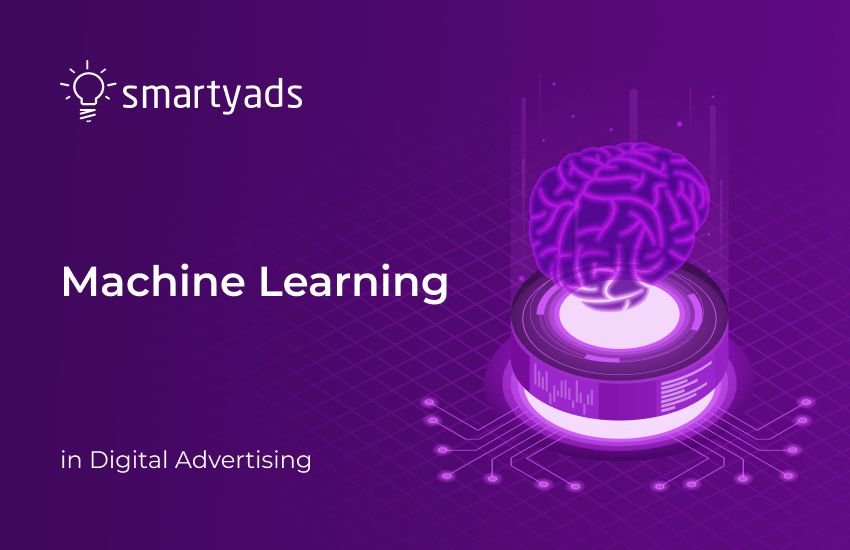A few decades ago the audience targeting was like standing on a roof with a megaphone. You could reach a lot of people, but not always the right people.
Mass advertising campaigns aren't the best solution for addressing your target audience if the purpose is to reduce costs, save time, and find new customers. However, the majority of manual ad placement burdens were resolved with the introduction of machine learning in advertising.
Now that the advertising industry has programmatic advertising, media buyers and advertisers have a chance to speak directly to target audiences, which, in turn, becomes possible to inbuilt machine learning algorithms.
Smart algorithms are the competitive advantage of programmatic so it's important to understand how they work in order to benefit from them to the fullest.
What is machine learning?
Machine learning is a subfield of artificial intelligence. The easiest example of how machine learning and artificial intelligence work is embodied in a decision tree.
Based on it a more complex gradient boosting algorithm is built, which is used by various search engines. Thanks to these algorithms and the relevant data a modern digital system, tool, or search engine can do the following things:
What ML and AI can do:
- Build music and shopping recommendations
- Perform voice recognition
- Make weather forecasts
- Rank web pages in search according to relevancy.
Machine learning algorithms get smarter when they receive new data. Data means everything for a machine learning system because based on it any system today can interpret the trends, and learn from them in order to make decisions and predictions in the future.
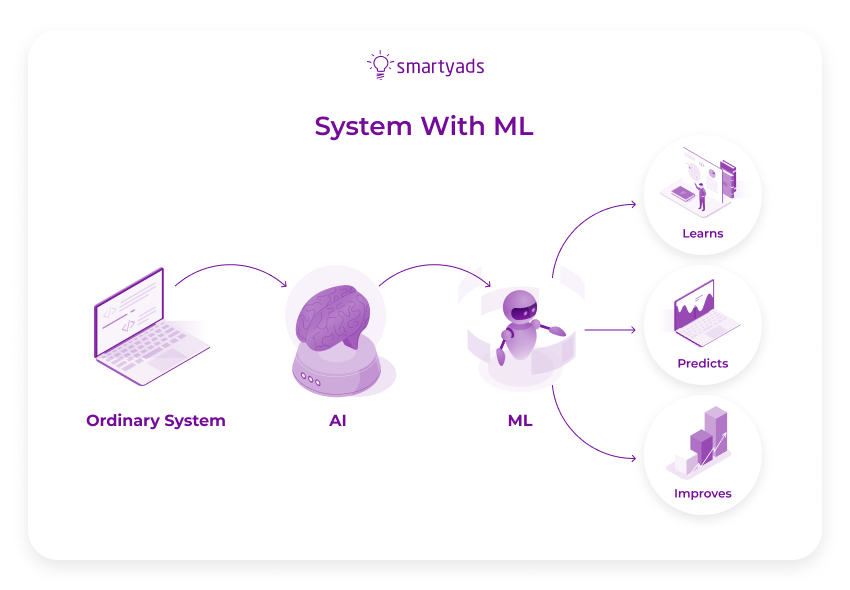
The machine learning model is applied in many industries from particle physics to marketing.
This way, for instance with machine learning the CRM works not only as a data aggregation tool but rather as a smart tool that analyzes the data - for example, which types of leads convert best, during what month the customers are most active, and so on.
Deep learning
Deep learning is another smart algorithm that's frequently applied in marketing tools.
Deep learning helps to analyze little nuances of the human behavior on the web so that it makes it possible to predict e.g., the emotional impact of the message, impact of opinions expressed on social media (thus, it can be useful for running campaigns on social media platforms and adjusting the message on advertising creatives).
Based on this information, it is then possible to predict what kind of message would work best in this environment and for certain types of visitors. Often machine learning is also associated with reinforcement learning as a method that is supposed to reward desired behaviors and/or restrict undesired ones.
Examples of ML and AI tools that can be applied in marketing:
- A chatbot
- A system for email automation
- A CRM
- An eCommerce tool that assesses customer reviews
- A programmatic advertising platform
- A tool for analytics/predictive analytics
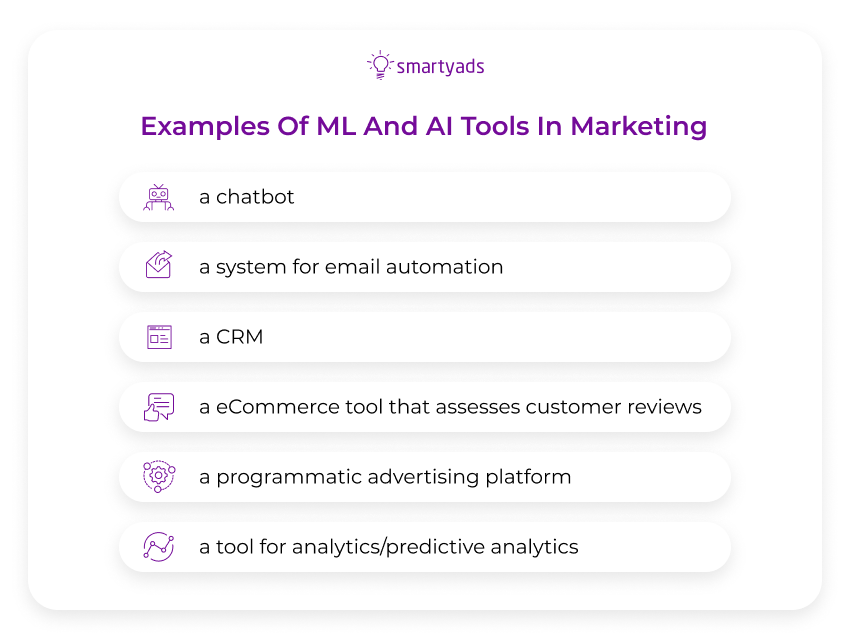
The development of machine learning changed the world of digital advertising dramatically. But what functions do machine learning systems are in charge of when we talk about online advertising?
Tasks of machine learning in advertising
Same as for other industries, the main task of online advertising machine learning is to analyze data points and detect correlations that are not so obvious to the human brain.
In simple terms, in the industry of digital advertising, machine learning helps the brand to draw conclusions about customer needs, create effective ad campaigns, and optimize campaign performance on the go.
ML and AI applications become popular among businesses that run B2B ad campaigns.
Benefits of ML and artificial intelligence technologies applied in B2B advertising:
More than 84% of experts in digital advertising and marketing think that AI and ML are the main components that enable the most effective ad personalization.
- 43% of marketing executives consider AI and ML as the main factors that help them to innovate in 2022.
- 83% of early adopters of AI-driven advertising systems achieved substantial (30%) or moderate competitive advantage (53%).
- Essentially, artificial intelligence and machine learning algorithms can be effective for all stages of online advertising, including customer acquisition and retention.
- With traditional advertising approaches, ad agencies have a very limited understanding of how to target audience of the brand.
The same happens with companies and independent advertisers who run advertising campaigns independently. However, modern marketing or advertising system can accumulate a large amount of data about users and their behavior.
Advertisers and media buyers are primarily interested in the opportunities for a personalized user experience that ML algorithms can provide. However, the list doesn't end on it. Artificial intelligence and machine learning in advertising fuel many capabilities.
What ML can do in marketing
- Ad creation
- Creating and managing audience segments based on a big data
- Running predictive analytics
- Organizing performance optimization (plus, decreasing advertising costs)
- Getting recommendations regarding advertising campaigns management in real-time.
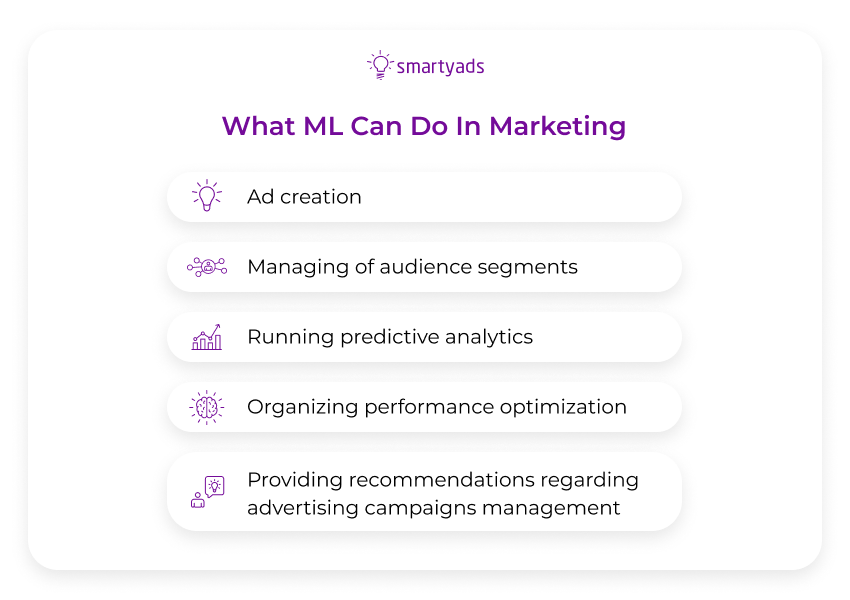
As you can see, the areas of ML application in advertising are endless but narrow down the scope to see what wonders can machine learning and big data do in a programmatic system.
How machine learning in programmatic improves advertising performance
Machine learning technology is something very trendy these days but how exactly does it manage to target users, organize media buying, and the ad delivery when we talk about automating the ad process?
In mentioning ML advertising one cannot forget about programmatic advertising, which is almost entirely built on data. Programmatic platforms like DSP make it easy for advertisers and marketers to automatically purchase the ad impressions without human intervention.
Being almost entirely powered by data, programmatic systems deliver the ads to the Internet users automatically in a few seconds and with a high level of precision. As a result, the users see the ads that are specifically tailored to their interests.
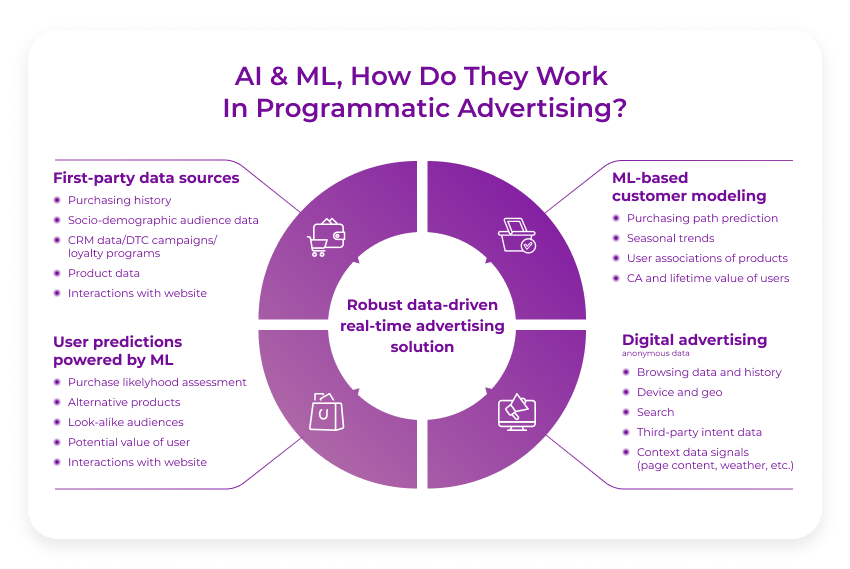
AI and ML algorithms are at the very essence of how programmatic works
It is worth pointing out that benefits provided by programmatic are almost entirely driven by AI and ML algorithms coupled with convenient automation.
In order to understand, let's briefly review how a programmatic system makes it possible to deliver targeted advertising to potential customers.
Here's how programmatic works in the nutshell
- A user enters a website/app and while the page is being loaded, the data contained in the cookies is passed to the SSP that the publisher uses.
- The SSP then ties the data about the user with data about the ad placement and sends it in the request to the DSPs so that advertisers could bid on it.
- The DSP, in turn, matches the data in the request with data about the ad campaign configured by the advertiser (targeting criteria and other factors). The DSP takes a decision on whether to bid on such an impression or not. If the impression is suitable for the advertiser, DSP sends a bid response and takes part in the programmatic auction.
- The auction is normally taking place on an ad exchange. DSPs that are getting interested in serving the impression start bidding on it. Smart algorithms define the bidder who wins and gets the right to serve their ad creative to this user.
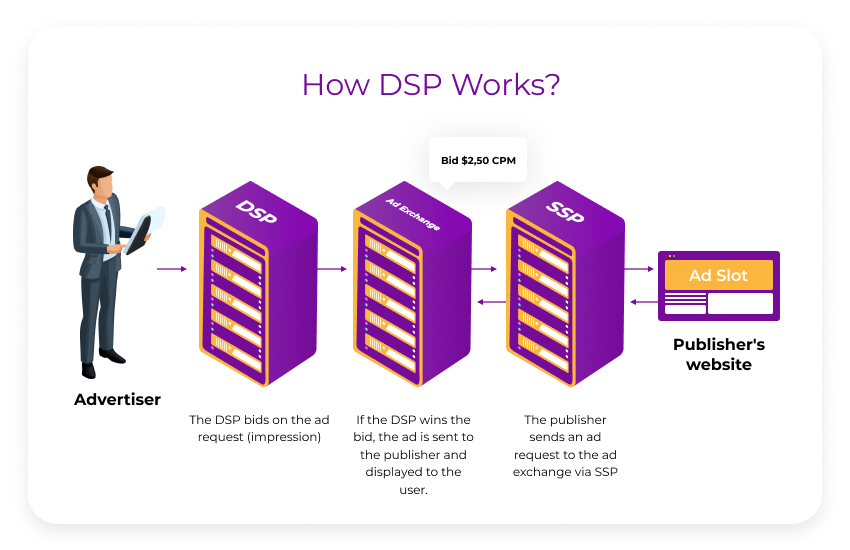
That's what is called machine learning advertising or targeted advertising - almost every process in such flow is automated with algorithms.
Plus, the advertiser doesn't have to show the same ad to everyone - the message is only delivered to target audiences, so that relevance could be maintained at the highest level.
Now let's review how this process helps to reach better advertising outcomes.
It keeps ads personalized
The mechanism of programmatic ads delivery described above explains how the advertiser's budget is being saved thanks to the elimination of irrelevant impressions. At the same time it also clearly explains how the advertising experience gets personalized for every user.
Users are getting served with ads based on their data portrait. It means that even if different users open the same web page they will see different ads based on the data contained in their cookies.
Certain platforms also have predictive targeting, the capability that makes it possible to deliver ads to users based on the likelihood of purchase (thanks to the certain data sets).
The ad spend gets reduced
As we mentioned above, precise targeting enabled by smart algorithms of programmatic helps advertisers and companies to run ads without spending extra money on irrelevant impressions.
Geolocation, age range, language, OS, browser type, and more data points make it possible to deliver ads according to robust digital portraits of customers.
With this, those people whose digital characteristics don't fall within targeting will be left outside ad serving.
This way the advertiser won't pay for serving impressions to people who will never convert (because your product or service is irrelevant to them).
Because of this, ad spend gets significantly reduced and the advertiser pays only for those impressions or ad clicks that are really valuable and relevant to the user.
Example of how ad spend gets reduced with ML on SmartyAds DSP
The example of smart algorithms that can additionally reduce ad spend is represented on SmartyAds DSP, it is called adaptive CPM.
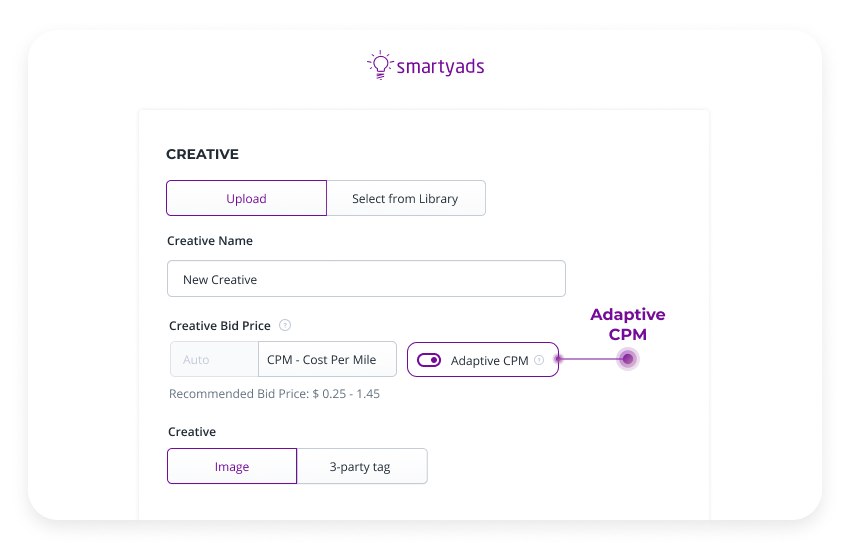
It is a feature on DSP that reduces the CPM for advertisers by automatic adjustments of the bids to the most optimal level.
This way the advertiser never overpays but at the same time wins the auctions since the bid level stays competitive enough.
As a result, advertisers pay less for served ads and save the budget. The feature can be activated in the dashboard with a toggle. After activation, the advertising campaigns will be optimized by the system on the go.
Machine learning helps to improve ad creatives
Typically in a programmatic advertising system, (including such platforms as Google Ads) machine learning helps to solve challenges of data application for various purposes, including ad creative improvement.
Different ad creatives can show different results. Details such as font, formats, colors, sizing, and wording - all these can have a severe impact on the success of the overall ad campaign performance.
As we already discovered, with machine learning, it is already possible to predict how your target audience will react to different types of messages depending on their habits, personality types, as well as many other at times unobvious factors.
The good news is, that many programmatic platforms already have in-built A/B testing functionality for creatives and even design tools for adjusting the messages or automatic improvement of ad images.
With more data about advertising creatives and their performance (this can be tracked with third-party tags and pixels on DSP), media buyers can optimize their ads structure and content. As a result of such creative optimization, advertisers can achieve a much better click-through rate.
Example of how ML improves creatives on SmartyAds DSP
An in-built proprietary algorithm on SmartyAds DSP resizes the creative sizes so that they fit more ad spaces, this feature is called creative autoresize.
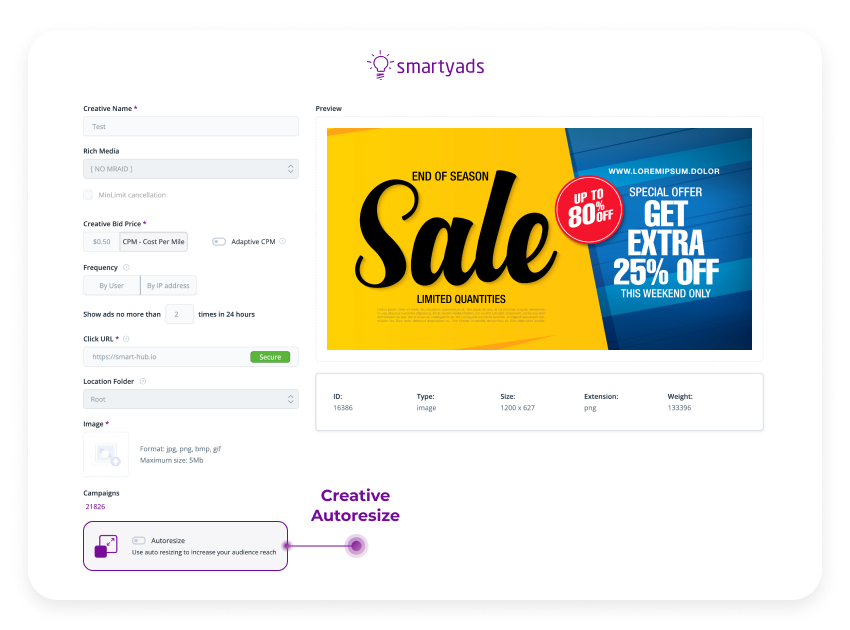
The essence of work of this feature - it helps to fill as many ad placements as possible thanks to which advertisers reach more customers on all mediums. This feature can be valuable for resizing non-standard banners.
This way advertisers don't have to design separate ad images for various kinds of placements - it is enough to activate the toggle in the dashboard and the creative size will be automatically optimized on the go.
Machine learning drives more clicks on the ads
CTR optimization is also an important objective when you are optimizing an advertising campaign. Thanks to the constantly processed data about clicks that take place on a particular source, the smart DSP system can also draw conclusions.
Based on these conclusions the platform will be prioritizing the best-performing sources for the advertising campaigns in the future. Let's review how it works in practice.
Example of how ML increases the number of clicks
SmartyAds DSP has a proprietary feature called the click booster. This tool is supposed to analyze the data about particular sources and then improve click through rate for the advertiser based on such insights.
While the campaigns are running the system learns and then develops the interpretation keys according to which the decision-making is done.
This way, for instance, if the data in the keys indicates that the source has poor clickability for selected targeting criteria (based on the previous experiences), then it won't be prioritized. If the source reaches a particular bar when it is regarded as high-performing, then the source will be given a preference.
This way the likelihood of clicking on the ad increases and this, in turn, generates more conversions and overall performance. In order to activate this function on SmartyAds DSP.
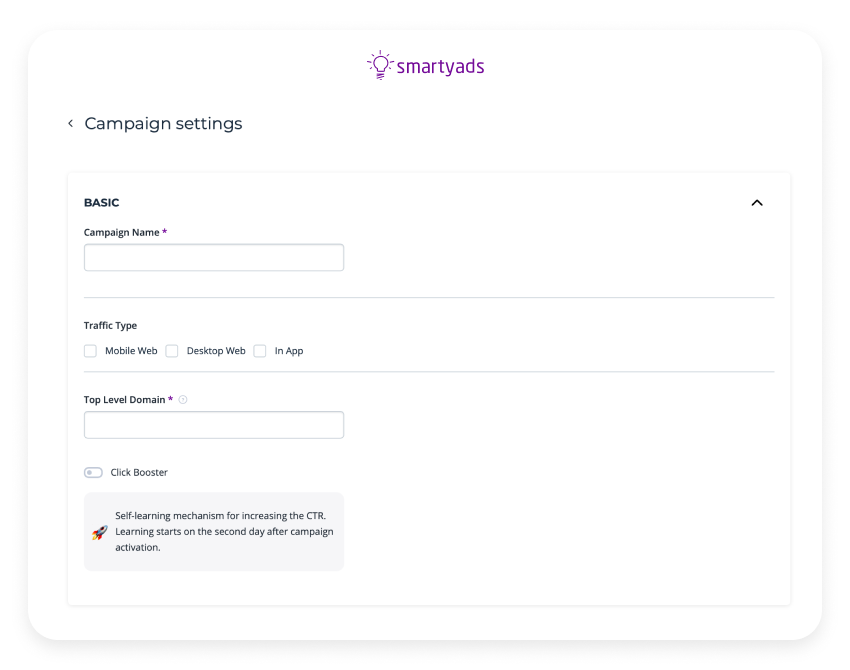
The data powers strong analytics
Keeping track of big data and analytics can be quite tiresome when done manually. Machine learning has great potential to make this process much faster and more precise.
There are always a huge number of factors within even one campaign that can be adjusted to improve ad performance.
The machine learning algorithm can give you insights regarding what these exact factors are and how you should change them in order to build a winning campaign based on data you input, as well as your goals, budget, and other variables of your choice.
Furthermore, over time the system gets smarter, especially when the amount of data you gather increases and boosts the accuracy of an algorithm.
Machine learning advertising is predictive
Imagine that you could know the outcome of your campaign before it is actually finished. Well, with machine learning this is no longer a fantasy - once you start a campaign, an algorithm starts analyzing it in real-time, comparing it to your previous campaigns, and adding customer behavior on top of it.
After you have a whole story it is easier to predict what a big picture might look like. This, of course, doesn’t mean that a machine could make all the decisions humans do, but at least it could save some of your time and budget.
Another important feature of algorithm-based predictions is that kind of “outside-of-the-box” thinking many humans wouldn’t dare to apply. Not limited by cultural or social assumptions that bias our strategies, machine learning can uncover lots of new potential approaches we might have missed. Some of those revelations can play a defining role in your campaigns’ budget optimization.
To conclude:
Personalized advertisements are trending, thanks to machine learning and artificial intelligence as they turn targeting precise and advertising campaigns effective.
A wise advertiser would always keep track of the latest technological developments and the best ways of their applications.
The usage of machine learning in online advertising has already shown impressive improvements in targeting, ad performance, and campaign optimization. One can easily observe this technology in action using a demand-side platform that employs the most wanted algorithms for campaign optimization.
